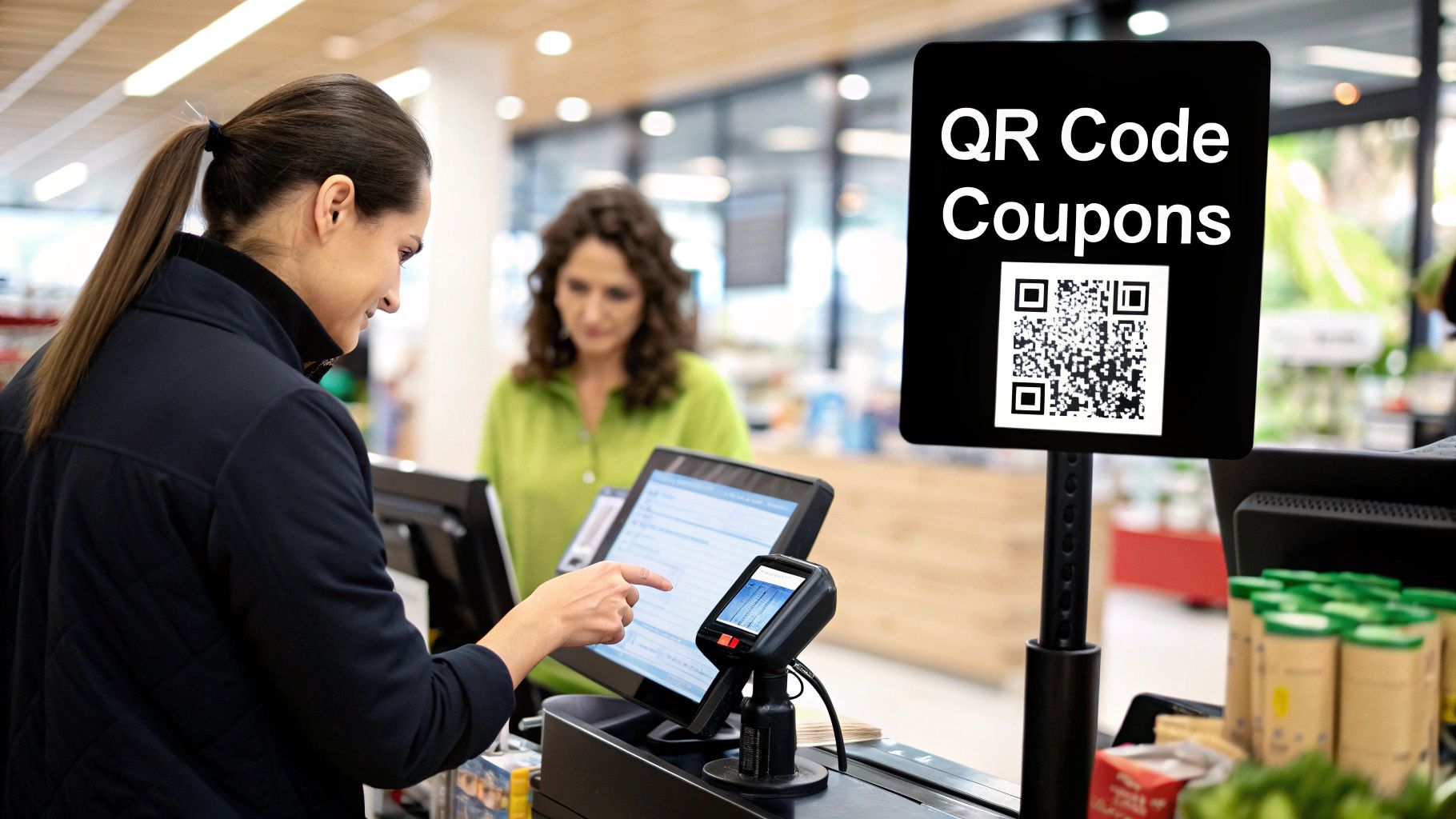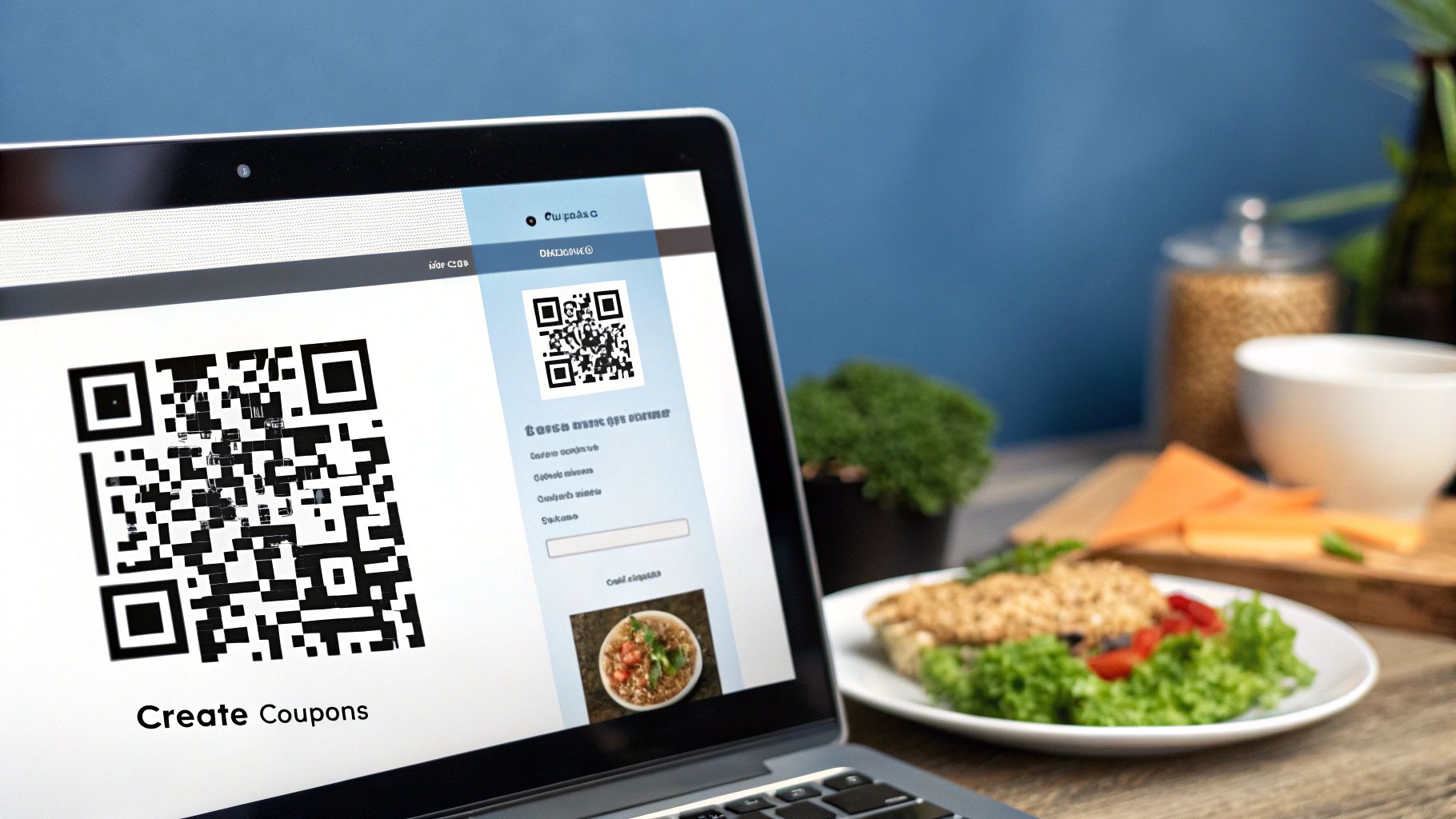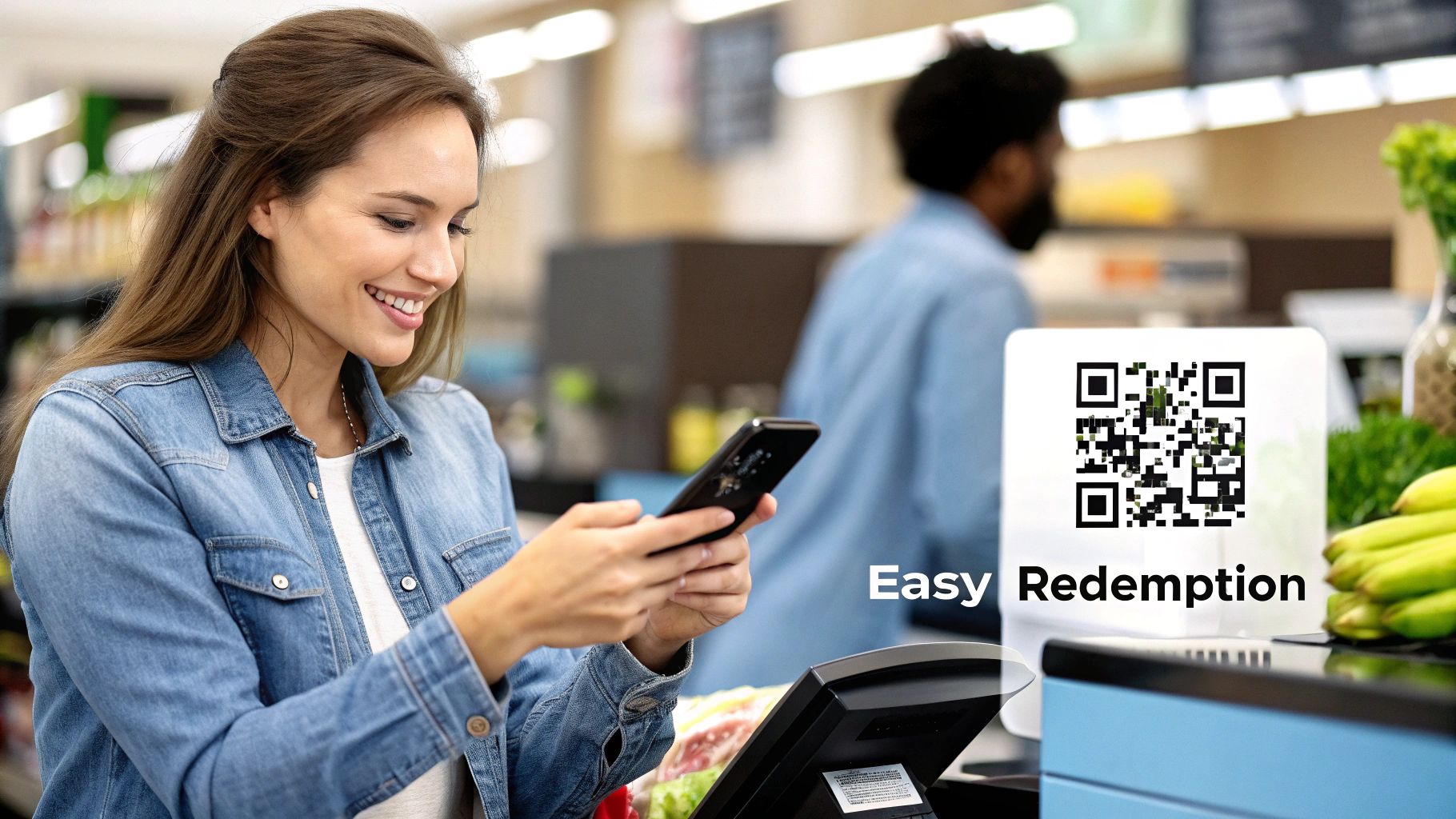Boost Sales with QR Code Coupons: A Practical Guide
June 7, 2025

Businesses are constantly searching for effective ways to engage customers and increase sales. QR code coupons have emerged as a powerful tool, merging the appeal of a discount with the convenience of mobile technology. This isn't just a trend - it's a response to shifting consumer habits and the need for more dynamic, data-informed marketing.
This guide will walk you through the entire process - from understanding why they work to creating, distributing, and tracking your own QR code coupon campaigns.
Why QR Code Coupons Are Effective
The shift to digital coupons powered by QR codes offers distinct advantages over traditional paper methods. They provide instant access, deliver measurable results, and align with modern consumer behavior.
Instant Access and Measurable Results
The primary appeal of QR code coupons is their immediacy. Customers can scan a code with their smartphone and instantly access a discount or offer, removing the friction of clipping paper coupons or entering complex codes.
For businesses, this interaction generates valuable data. You can track how many people scan your coupon, when they scan it, and where. This allows you to:
- Measure campaign performance in near real-time.
- Make informed adjustments to your offers.
- Understand customer preferences more deeply.
For example, a cafe can analyze which QR code deals are most popular during the morning rush versus the afternoon lull, enabling them to tailor future promotions for maximum effect.
Cost-Effectiveness and Sustainability
Digital distribution via QR codes significantly reduces costs. Businesses can eliminate the expenses associated with printing and physically distributing paper coupons. This also makes QR code coupons a more environmentally friendly and sustainable marketing option, which can resonate positively with your customers.
Growing Consumer Adoption
The use of QR codes for all purposes, including marketing and payments, has become widespread. As consumers grow more comfortable with the technology, their willingness to engage with QR code-based offers increases. Industry analysis shows that the number of US smartphone users redeeming QR code coupons is projected to grow significantly, reaching over 100 million by 2025. This growing adoption makes it a reliable channel for reaching a broad audience.
The Psychology Behind a Successful Scan

A successful QR code coupon campaign hinges on understanding what motivates a customer to scan. It's not just about the technology - it's about trust, clarity, and value.
The Core Factors: Trust, Design, and Value
Three key elements influence a customer's decision to scan your QR code:
- Trust: Customers are more likely to scan a code if it comes from a brand they recognize and trust. Your branding on and around the QR code is essential for building this confidence.
- Design and Clarity: The visual presentation matters. A well-designed QR code with a clear call to action (CTA) is far more effective. Use contrasting colors for easy scanning and add a simple, direct instruction like "Scan for 20% Off Your Order" so users know exactly what to expect.
- The Offer: The perceived value of your coupon is a powerful motivator. A compelling offer, such as a significant discount, a "buy-one-get-one-free" deal, or an exclusive item, provides a strong incentive to act.
Other Important Considerations
- Placement: Where you put your QR code is critical. Place them in high-traffic, visible locations where customers have time to scan, such as on menus, table tents, product packaging, or at the point of sale.
- Social Proof: Highlighting that others are using and benefiting from your coupons can build trust. Testimonials or showing the number of coupons already redeemed can encourage hesitant customers.
- Security: Be transparent about data privacy. A simple statement assuring customers that their information is secure can alleviate concerns and increase engagement.
By addressing these psychological triggers, you can significantly increase the chances that a customer will not only see your QR code but also scan it and make a purchase.
A Step-by-Step Blueprint for Creating QR Code Coupons
Ready to launch a campaign? This blueprint will guide you through the essential steps, from initial design to final integration.
1. Design a Scannable and Appealing QR Code
A functional QR code is the bare minimum. A great QR code is designed to be scanned.
- Optimal Size: Make sure the code is large enough to be scanned easily from a typical distance. A code that is too small will only cause frustration.
- High Contrast: Use a dark code on a light background. Most scanning apps perform best with high-contrast images. Avoid color combinations that blend together.
- Clear Call to Action (CTA): Never assume people know what to do. Place a concise, action-oriented phrase near your QR code, such as "Scan Here for Today's Deals" or "Scan to Get Your Coupon."
2. Choose the Right QR Code Generator
Your choice of generator will determine the capabilities of your campaign. Platforms like RecodeQR provide options that cater to different business needs.
- Static QR Codes: These codes link to a fixed destination (like your website's homepage). They are permanent and simple to create. They are a good choice for information that doesn't change.
- Dynamic QR Codes: These are the preferred choice for marketing campaigns. The destination URL can be changed at any time, even after the code has been printed. More importantly, they allow you to track scan data - including the time, location, and device type used for each scan.
Using dynamic QR codes from a service like RecodeQR gives you the power to measure your campaign's effectiveness and gather valuable insights into customer behavior.
3. Structure a Compelling Offer
The offer itself is the core of your coupon. Design offers that provide clear value and encourage action. Consider options like:
- Percentage-based discounts (e.g., 20% off).
- Fixed-amount discounts (e.g., $5 off a purchase over $25).
- Buy-One-Get-One (BOGO) deals.
- Limited-time offers to create a sense of urgency.
4. Integrate with Your Point-of-Sale (POS) System
For a smooth customer experience, ensure your QR code coupon system can be easily handled at checkout. This could be as simple as staff visually verifying the coupon on the customer's phone or a more advanced integration where the discount is automatically applied when the code is scanned by your POS system.
The following checklist summarizes the creation process:
| Step | Tools Required | Estimated Time | Best Practices |
|---|---|---|---|
| 1. Design the QR Code | QR Code Generator (e.g., RecodeQR) | 10-20 minutes | Use high contrast, include a clear CTA, ensure proper sizing. |
| 2. Create the Coupon | Your marketing or sales platform | 20-40 minutes | Offer clear value, use tiered or limited-time deals. |
| 3. Plan for Redemption | Your POS System or staff training plan | 1-2 hours | Ensure a seamless checkout process for both staff and customers. |
| 4. Plan Distribution | Email, Social Media, Print Materials | Ongoing | Target specific customer segments, place codes in high-visibility areas. |
How to Distribute Your QR Code Coupons Effectively

An excellent coupon is useless if no one sees it. Strategic distribution is key to maximizing your campaign's reach and impact.
Digital Distribution Channels
Digital channels offer cost-effective and highly targeted ways to reach your audience.
- Email Marketing: Send QR codes directly to your subscribers. You can segment your list to send personalized offers based on past purchase behavior, increasing the relevance and effectiveness of your campaign.
- Social Media: Embed QR codes in your posts, stories, and profiles on platforms like Instagram and Facebook. You can run interactive campaigns, like a contest where scanning the code is a required entry step.
- Your Website: Place QR code coupons on your homepage or product pages to convert visitors into customers.
Physical Distribution Channels
Physical placement bridges the gap between your offline presence and your online offers.
- In-Store Displays: Place QR codes at checkout counters, on table tents, or on signage in high-traffic areas to catch customers' attention.
- Product Packaging: Print a QR code directly on your product's packaging. This can encourage repeat purchases by offering a discount on a future order.
- Receipts: Add a QR code to the bottom of your sales receipts to incentivize customers to return.
- Print Advertising: Include QR codes in flyers, posters, and magazine ads to make your traditional marketing interactive and trackable.
Partnering for a Wider Reach
Collaborate with complementary, non-competing businesses to cross-promote. For example, a gym could partner with a local health food store, with each business displaying QR code coupons for the other. This strategy introduces your brand to an established, relevant audience.
Tracking Performance and Optimizing for Success
The true power of dynamic QR codes lies in the data they provide. Tracking your campaign's performance is not just about seeing how many scans you get - it's about understanding what works so you can do more of it.
Key Metrics to Track
Go beyond the basics. While the scan rate is important, other metrics provide a much clearer picture of your campaign's return on investment (ROI).
- Scan Rate: (Total Scans / Total Views or Prints) - Shows initial engagement.
- Conversion Rate (Redemption Rate): (Total Redemptions / Total Scans) - Tells you how many people who scanned the code actually used the coupon. This is a critical indicator of offer quality.
- Scans by Location/Time: Helps you understand where and when your audience is most active, allowing you to optimize the placement of your codes.
- Customer Acquisition Cost (CAC): (Total Campaign Cost / Number of New Customers Acquired) - Shows how much it costs to gain a new customer through the campaign.
- Return on Investment (ROI): ((Revenue from Campaign - Campaign Cost) / Campaign Cost) - The ultimate measure of profitability.
The table below offers a simple dashboard for tracking your key performance indicators (KPIs).
| Metric | Good Performance Benchmark | How to Calculate |
|---|---|---|
| Scan Rate | > 5% | (Total Scans ÷ Total Coupons Distributed) |
| Conversion Rate | > 25% | (Total Coupon Redemptions ÷ Total Scans) |
| Customer Acquisition Cost (CAC) | Lower than customer lifetime value | (Total Campaign Cost ÷ New Customers Acquired) |
| Return on Investment (ROI) | > 1 (Positive Return) | ((Revenue - Cost) ÷ Cost) |
Note: Benchmarks can vary significantly by industry and campaign type. Start by measuring your own performance and aim for continuous improvement.
The Process of Optimization
- Gather Data: Use a platform with robust analytics, like RecodeQR, to collect data from your dynamic QR codes.
- Analyze and Identify Patterns: Look for trends. Are QR codes on your receipts performing better than those in your emails? Is a 20% discount converting better than a $5 discount?
- A/B Test: Don't guess what works best - test it. Create two versions of a coupon (e.g., with different calls to action or offers) and distribute them to similar audiences. Measure which one performs better and adopt the winner for future campaigns.
- Refine and Repeat: Use your insights to make your next campaign even better. Optimization is an ongoing cycle of testing, learning, and improving.
By taking a data-driven approach, you can move from simply running promotions to building a fine-tuned marketing engine that consistently drives sales and fosters customer loyalty.
Key Takeaways for Your Business
Implementing a QR code coupon strategy can be a highly effective way to grow your business. Here is a summary of the most important points:
- Focus on Value and Trust: A successful scan starts with a compelling offer from a brand the customer trusts. Always include a clear call to action.
- Use Dynamic QR Codes: The ability to track scans and edit the destination link is essential for any serious marketing campaign. A platform like RecodeQR provides the tools you need for this.
- Distribute Strategically: Place your QR codes where your target audience will see them, using a mix of digital and physical channels for the broadest reach.
- Track, Measure, and Optimize: Go beyond simple scan counts. Track conversion rates and ROI to understand what truly works. Use A/B testing to continuously improve your results.
- Integrate for a Smooth Experience: Ensure the redemption process is simple for both your customers and your staff by integrating it into your existing workflow or POS system.
By following this practical guide, you can build a sustainable QR code coupon program that not only boosts immediate sales but also builds stronger customer relationships and provides valuable data for long-term growth.
Ready to create your QR code?
RecodeQR is the easiest way to create QR codes you can track and edit anytime.
Free 14-day trial. No credit card required.